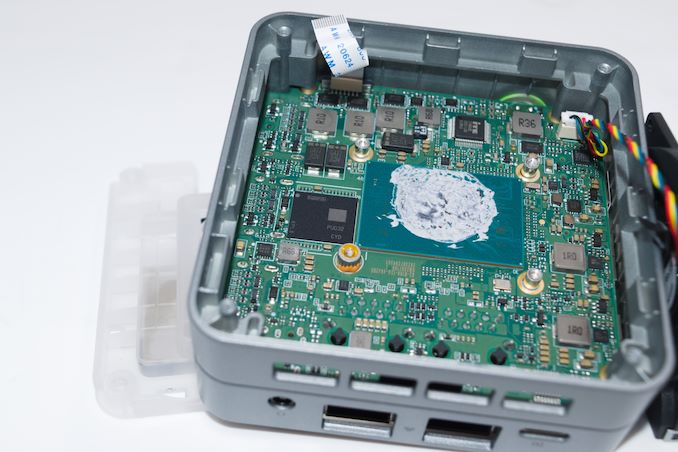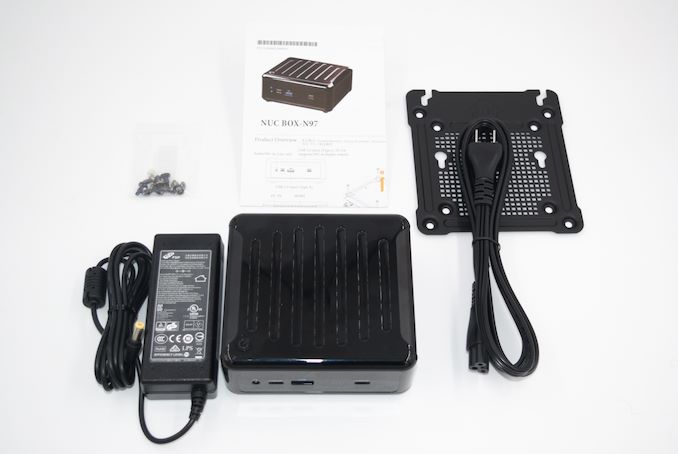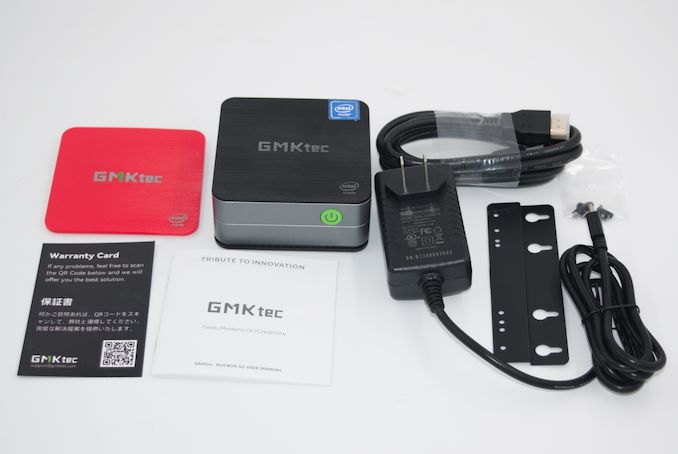ASRock Industrial NUC BOX-N97 and GMKtec NucBox G2 Review: Contrasting Compact ADL-N Options
by Ganesh T S on October 6, 2023 9:45 AM EST- Posted in
- Systems
- UCFF
- Mini-PC
- ASRock Industrial
- Alder Lake-N
- micro-PC
- GMKtec

Intel introduced a separate microarchitecture for low-power / low-cost x86 systems in the 2008 Silverthorne Atom processors. Variation of the microarchitecture in different product families has since helped the company to span a wider performance / power efficiency range. From 2008 to 2020, each product family opted for either the Atom-class microarchitecture or the Core-class one. However, the introduction of hybrid CPUs (starting with the short-lived Lakefield) saw the placement of cores based on both microarchitectures in the same die. The Tremont microarchitecture (developed as part of the Atom-family) made its debut in Lakefield before gaining wider market presence through Jasper Lake and Elkhart Lake. Its successor (Gracemont) is adopting a similar trajectory. After its introduction in Alder Lake (ADL), it underwent further refinement in Raptor Lake (RPL). The hybrid processors in these two families teamed up the Gracemont efficiency cores with the Golden Cove (ADL) / Raptor Cove (RPL) performance cores. Eventually, Intel released a new line of processors under the 'Alder Lake-N' (ADL-N) tag comprising only the Gracemont cores, a pared-down integrated GPU, and premium connectivity options removed. As a replacement for the Tremont-based Jasper Lake SoCs, ADL-N has found its way into a variety of entry-level computing systems including notebooks and compact desktops.
ASRock Industrial's lineup of ultra-compact form-factor (UCFF) systems - the Intel-based NUC BOX series and AMD-based 4X4 BOX series - has enjoyed significant market success, allowing the company to regularly introduce products based on the latest Intel and AMD offerings. At the same time, the expanding market for compact computing systems has also brought many Asian companies such as ACEMAGIC, Beelink, GEEKOM, GMKtec, and MinisForum into play. These vendors are essentially brands for OEMs / ODMs with experience in product design and manufacturing experience. The rise of e-commerce has allowed them to find an outlet for their product designs via direct-to-consumer sales.
As ADL-N ramps up, we are seeing a flood of low-cost compact desktop systems based on it from multiple vendors. We took advantage of this opportunity to source two contrasting ADL-N mini-PCs - the ASRock Industrial NUC BOX-N97 and the GMKtec NucBox G2. Though both systems utilize a quad-core ADL-N SoC, the feature set and target markets are very different. The review below provides a detailed analysis of the system features, build, performance profile, and value proposition of the NUC BOX-N97 and the NucBox G2.
Introduction and Product Impressions
Rapid strides have been made in CPU performance and power efficiency over the last decade. This has resulted in compact systems equipped with sub-15W TDP SoCs becoming powerful enough to replace bulky desktops for many use-cases. This trend gained mainstream attention with Intel's introduction of the ultra-compact form-factor (4in. x 4in.) NUC in the early 2010s. The 4x4 form-factor continues to hold sway even today, as evidenced by the variety of UCFF systems introduced by multiple vendors every year. The ASRock Industrial NUC BOX-N97 we are looking at in this review utilizes the tried and tested 4x4 form-factor.
The 4x4 form-factor was chosen in order to be able to accommodate a 2.5" disk drives and SODIMM kits. Since that time, both storage and memory technologies have evolved significantly. High-capacity M.2 2242 / 2230 SSDs are becoming common, and soldered RAM is not being met with as much derision as before. These have contributed to some vendors introducing micro-PCs with a sub-4x4 footprint. The second system evaluated as part of this review, GMKtec's NucBox G2, is one such micro-PC measuring 3.4 in x 3.4 in.
ASRock Industrial NUC BOX-N97
ASRock Industrial has been serving the industrial systems market with compact boards and mini-PCs since the days of Intel Skylake (6th Gen) / Braswell. Having taken over ASRock's Beebox design, the company's product releases in this category have had a regular cadence.
The company has been maintaining a line of actively-cooled 4in. x 4in. NUC BOX systems based on Intel's low power microarchitecture. In the Tremont era, the company introduced the Elkhart Lake-based NUC BOX-J6412. This was the successor of the NUC BOX-3xx0 based on the Braswell SoCs. The NUC BOX-N97 is the company's latest product in the lineup. This Gracemont version utilizes the ADL-N Intel Processor N97. Similar to other products in the NUC BOX line, the system if offered as a barebone, with the ability to accommodate a single DDR4-3200 SODIMM and either a 2.5" SATA drive or a M.2 2280 SATA / NVMe SSD.
In addition to the main unit, the NUC BOX-N97 package comes with a VESA mount and corresponding screws, and a 65W (19V @ 3.42A) power adapter. A geo-specific power cord is supplied along with a product overview / installation brochure. The gallery below provides a comprehensive look at the chassis design and I/O ports placement. The space for the 2.5" drive is on the underside of the unit (the one that needs to be separated out in order to install the RAM and disk drive). The SATA cable is affixed to the underside, as shown in one of the gallery pictures.
We opted to install a 16 GB Crucial DDR4-3200 CL 22 SODIMM in the system along with a SK hynix Gold P31 NVMe SSD. It must be noted that the M.2 slot accepts both SATA and NVMe SSDs, with the latter operating at PCIe 3.0 x1.
Every NUC BOX system reviewed before had been equipped with dual SODIMM slots. The NUC BOX-N97 has only one slot, though (as the ADL-N SoCs have only a single memory channel). Except for the DRAM slot, the rest of the NUC BOX-N97's internals are very similar to the other NUC BOX systems reviewed before. The system uses a notebook-style cooler. There are no bells and whistles, and the chassis design and thermal solution are tried and tested versions.
GMKtec NucBox G2
The GMKtec's NucBox G2 is the company's follow-up to the still-active Jasper Lake-based NucBox 7. This micro-PC family adopts the ports-all-around scheme that we already saw in last week's review of the ACEMAGIC T8 Plus. Like the ACEMAGIC system, the NucBox G2 also comes with soldered LPDDR5 RAM. A semblance of upgradability is maintained, thanks to the use of a M.2 2242 SATA SSD. The system is not available as a barebone kit. Our review configuration came with 12 GB of LPDDR5-4800 RAM and a 1 TB SATA SSD with Windows 11 Pro pre-installed.
In addition to the main unit, the NucBox G2 package comes with a HDMI cable, wall mount with associated screws, an user manual, a warranty card, and a 36W (12V @ 3A) geo-specific wall wart with a Type-C output. Unfortunately, this is a non-conforming USB Type-C application, and the wall wart can't be used reliably with other devices conforming to USB-PD sink standards. The adapter can only be used with the Type-C power input-only port of the NucBox G2. The top part of the main unit can be pried off easily to expose the M.2 2242 SATA SSD slot. GMKtec also offers an alternative colored top panel. Teardown pictures are provided in the gallery below along with a look at the placement of various I/O ports.
The teardown pictures show the M.2 SATA SSD surrounded by a plastic frame on which the WLAN antenna are mounted. Unscrewing the underside reveals a LED lighting base connected to the main board with a ribbon connector. A small notebook-style fan is also visible along with the associated copper heat spreader. The LED lighting base has open vents allowing the fan to suck in air and blow it out over the heat spreader fins. Taking off the heat sink and fan reveals the ADL-N package and a single DRAM package that incorporates four 24 Gbit Micron dice.

12 GB LPDDR5-4800 Package Adjacent to the Thermal Paste-Laden ADL-N Package
The soldered RAM is not user-upgradeable. However, the M.2 2230 slot for the WLAN component is accessible under the M.2 SATA SSD slot. The pre-installed SSD is from FuturePath, and seems to have the same SSD controller manufacturer as the FPT310 SSD seen in the ACEMAGIC T8 Plus review.
The NucBox G2 came with Windows Pro OS pre-installed, but we had to wipe it and install Windows 11 Enterprise to keep the testing environment consistent across different systems. The full specifications of the two review samples (as tested) are summarized in the table below.
| Systems Specifications (as tested) |
||
| ASRock NUC BOX-N97 | GMKtec NucBox G2 | |
| Processor | Intel Processor N97 Alder Lake-N 4C/4T, up to 3.6 GHz Intel 7, 6MB L3, 12W (PL1 = 12W / PL2 = 25W) |
Intel Processor N100 Alder Lake-N 4C/4T, up to 3.4 GHz Intel 7, 6MB L3, 6W (PL1 = 10W / PL2 = 25W) |
| Memory | Crucial CT16G4SFRA32A.C16FR DDR4-3200 SODIMM 22-22-22-52 @ 3200 MHz 1x16 GB |
Micron LPDDR5-4800 (Single-Channel / 4 x16) 52-44-44-104 @ 4800 MHz 12 GB |
| Graphics | Intel UHD Graphics (24EU @ 1200 MHz) |
Intel UHD Graphics (24EU @ 750 MHz) |
| Disk Drive(s) | SK hynix Gold P31 SHGP31-1000GM-2 (1 TB; M.2 2280 PCIe 3.0 x4 NVMe SSD, operating at x1) (SK hynix 128L 4D TLC; SK hynix Cepheus ACNT038 Controller) |
Futurepath S4GXH02TV6A01T0 (1 TB; M.2 2242 SATA III 6 Gbps) (?? NAND; ?? Controller) |
| Networking | 2x 2.5 GbE RJ-45 (Realtek RTL8125) Mediatek MT7921K (RZ608) Wi-Fi 6E (2x2 802.11ax - 1.2 Gbps) |
2x GbE RJ-45 (Realtek RTL8168/8111) Realtek RTL8852BE Wi-Fi 6 / Bluetooth 5 (2x2 802.11ax - 1.2 Gbps) |
| Audio | Realtek ALC256 (3.5mm Audio Jack in Front) Digital Audio with Bitstreaming Support over HDMI and Type-C (Alt DP) Ports |
3.5mm Audio Jack Digital audio and bitstreaming support over HDMI Outputs |
| Video | 2x HDMI 2.0b 2x Display Port 1.4a over Type-C Alt-Mode (up to 3 simultaneous 4096x2160 @ 60 Hz displays) |
2x HDMI 2.0b (up to 4Kp60) 1x DisplayPort 1.4a (up to 4Kp60) |
| Miscellaneous I/O Ports | 2x USB 3.2 Gen 2 Type-C w/ Alt DP Support (Front) 1x USB 3.2 Gen 2 Type-A (Front) 2x USB 3.2 Gen 2 Type-A (Rear) |
3x USB 3.2 Gen 2 (10 Gbps) Type-A |
| Operating System | Windows 11 Enterprise (22000.2416) | Windows 11 Enterprise (22000.2360) |
| Pricing | (Street Pricing on Oct 05th, 2023) US $260 (barebones) US $353 (as configured, no OS) |
(Street Pricing on Oct 5st, 2023) US $230 (as configured, w/OS) |
| Full Specifications | ASRock Industrial NUC BOX-N97 Specifications | GMKtec NucBox G2 Specifications |
In the next section, we take a look at the system setup and follow it up with a detailed platform analysis.

























20 Comments
View All Comments
markiz - Tuesday, October 17, 2023 - link
Is support really at all important, or at all, with machines like these?I've had a couple of PC over the years and they all lasted 10+ years with no failers of any compononets.
Nor as a home user have I ever considered BIOS update.
I imagine in business settings it's much different. Reply
hubick - Sunday, October 8, 2023 - link
"and soldered RAM is not being met with as much derision as before."this is where I stopped reading this article. Reply
meacupla - Sunday, October 8, 2023 - link
It's 12GB LPDDR5 on a 6W Celeron. It's fine.Even 8GB works fine at 1440p on that CPU.
4K, you might want 16GB. Reply
mode_13h - Monday, October 9, 2023 - link
> It's 12GB LPDDR5 on a 6W Celeron.Did you see the power consumption measurements? These things don't even *idle* at 6W! Reply
mode_13h - Sunday, October 8, 2023 - link
> The key aspect ... is the presence of the 'In-Band ECC' option.> ...
> We confirmed ... that this option would not be removed in a future BIOS version
> Apparently, Intel has decided to allow In-Band ECC as an official feature of the ... N97.
Excellent! Thank you!
If only they had used DDR5, this might be my next mini-PC!
> MemTest86 hang during memory testing of a known faulty SODIMM
> instead of reporting errors).
LOL, wut? I hope that's a Memtest86 bug, and not just what happens when you get memory errors with IB-ECC! Reply
ganeshts - Sunday, October 8, 2023 - link
Faulty SODIMMs can't guarantee only one- or two-bit errors. There could be more.The likely explanation for the hang is that IB ECC generates an ECC mismatch interrupt internally to the processor, and MemTest86 is not able to handle it.
MemTest86 will eventually need to add support for IB ECC interrupt handling / error status readouts. Reply
mode_13h - Sunday, October 8, 2023 - link
Thanks for the review & replying to me.> Faulty SODIMMs can't guarantee only one- or two-bit errors. There could be more.
Okay, I sort of assumed you had some idea of how many errors the DIMM had, like based on doing a memtest scan with ECC disabled. I've seen my share of DIMMs with only a handful of bad cells, so I assumed it was one of those.
> MemTest86 will eventually need to add support for IB ECC interrupt handling / error status readouts.
Yes. Sounds like a feature they need to add. Is this the memtest variant from PassMark Software? Reply
ganeshts - Monday, October 9, 2023 - link
Yes, I am using the PassMark variant.I have screenshots from mem testing the same SODIMM with the NUCS BOX-1360P/D4 (when they had the IB ECC feature enabled in the BIOS):
https://www.anandtech.com/show/18732/asrock-indust... Reply
mode_13h - Monday, October 9, 2023 - link
Submit a bug report on it For Great Justice! ReplyNextGen_Gamer - Tuesday, October 10, 2023 - link
@Ganesh T S - I don't think those memory bandwidth figures and specs are correct. GPU-Z is known to not have good support for Intel's lower-end line. I know this personally as an owner of the Intel NUC11ATKPE ("Jasper Lake"). Intel's ark website shows that Alder Lake-N has a single memory channel (64-bit). Running at its fastest, so either DDR5-4800 or LPDDR5-4800, would be 38.4GB/sec of bandwidth. That tracks and make sense with what Intel says their 13th-gen Core series max bandwidth is, being dual-channel DDR5-5600, at 89.6GB/sec.Alder Lake-N running in its single-channel DDR4-3200 config then should be only 25.6GB/sec. Reply